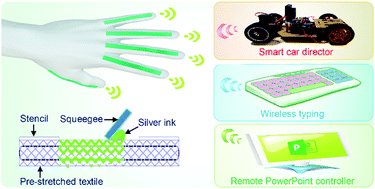Directly printed wearable electronic sensing textiles towards human–machine interfaces†
Abstract
Gesture control is an emerging technological goal in the field of human–machine interfaces (HMIs). Optical fibers or metal strain sensors as sensing elements are generally complex and not sensitive enough to accurately capture gestures, and thus there is a need for additional complicated signal optimization. Electronic sensing textiles hold great promise for the next generation of wearable electronics. Here, soft, deformable and ultrahigh-performance textile strain sensors are fabricated by directly stencil printing silver ink on pre-stretched textiles towards HMIs. These textile strain sensors exhibit ultrahigh sensitivity (a gauge factor of ∼2000), stretchability (up to 60% strain), and durability (>10 000 stretching cycles). Through a simple auxiliary signal processing circuit with Bluetooth communication technology, an intelligent glove assembled with these textile strain sensors is prepared, which is capable of detecting the full range of fingers’ bending and can translate the fingers’ bending into wireless control commands. Immediate applications, for example, as a smart car director, for wireless typing, and as a remote PowerPoint controller, bring out the great practical value of these textile strain sensors in the field of wearable electronics. This work provides a new prospective for achieving wearable sensing electronic textiles with ultrahigh performance towards HMIs, and will further expand their impact in the field of the Internet of Things.



 Please wait while we load your content...
Please wait while we load your content...